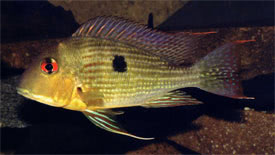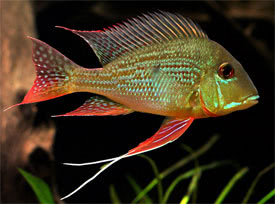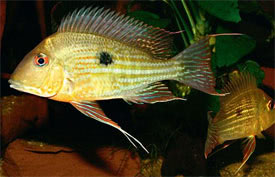
 Magyarul / Hungarian
Magyarul / Hungarian



- Scientific name: Geophagus surinamensis
- Common name: Red-Striped Earth Eater, Redstripe Eartheater
- Group: Cichlids
- Habitat: South America; Suriname
- Size: 25 cm.
- Biotope: Found in quiet pools and backwaters in Sarramacca, Maroni and Suriname Rivers among large root systems.
- Social behavior: Can be territorial when breeding, but generally peaceful. Should not be kept with more territorial and aggressive fish. Suitable for large community tanks.
- Diet: Omnivorous; All types of live foods, flakes, also accepts tablets, and regularly offer some vegetable or spirulina flake
- Breeding: Quite easy
- Tank: Minimum 240 litres
- Population: 1 couple for 240 litres
- Decoration: For substrate use sand or very fine gravel. Larger, sharper types of gravel should be avoided as it can cause injuries to their face and mouth. Plants should be hardy, planted in pots.
- Temperature: 22-26°C
- pH: 6-7.5
- Hardness: 4-8 NK°
- Lifespan: 10 years
Description: Red-Striped Earth Eaters have a yellowish or greenish base color, with beautiful, almost iridescent patterns of blue, green and red markings. They have a long, sloping forehead and eyes placed high on their head. Juvenile Red Striped Earth Eaters are not very attractive at all. These cichlids take 1-1.5 years to reach maturity and become beautiful and colorful fishes. Good filtration is essential, as their constant digging in the substrate. It is important to keep the water quality high, as they are susceptible to Hole In The Head disease if kept in poor conditions. As their common name suggests, they are ferocious diggers, foraging constantly for food in the substrate, and can easily uproot any plant from it.
Males have longer rays extending from the ends of their fins. Females might also have rays on their fins but far shorter than the male. Breeding can be encouraged by dropping pH, raising temperature and increasing the amount of frozen and live foods in the Surinamensis' diet. Eggs are generally laid on a smooth piece of rock or a small pit dug into the substrate. The female spawns usually 500 eggs. They are partial mouthbrooders, either parent will take the fertilised eggs in their mouth and hold them until hatching which occurs around 3 days later. After hatching, the fry will stay close to their parents, taking shelter in their mouths if danger threatens.
































